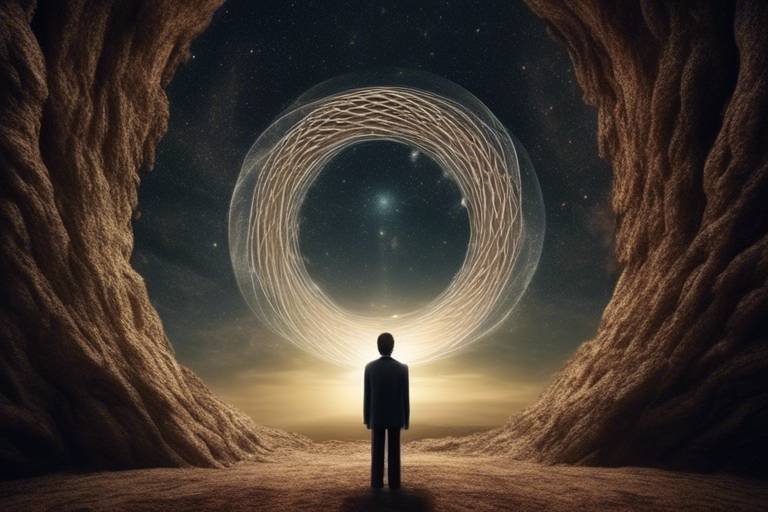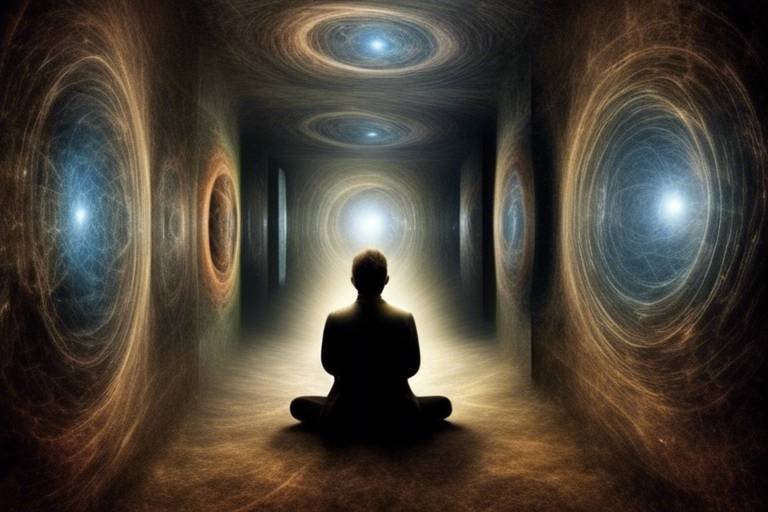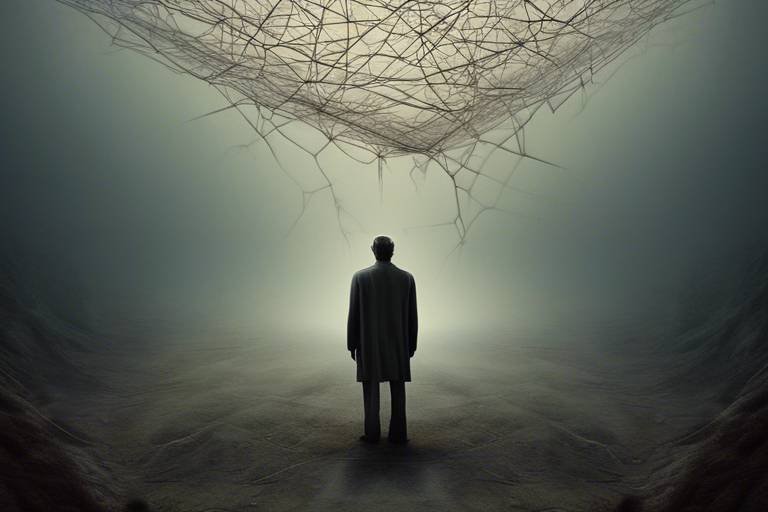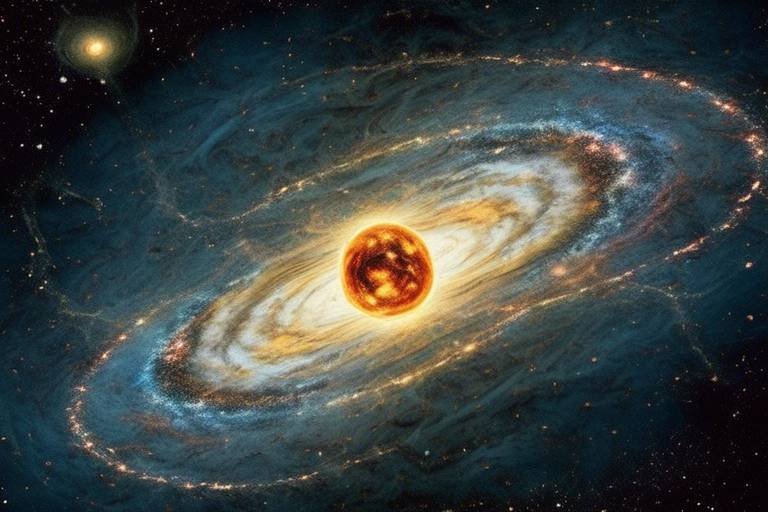Hierarchy of Existence - An Ontological Perspective
Have you ever pondered the nature of existence? It’s a question that has intrigued philosophers, scientists, and curious minds alike for centuries. The concept of existence is not just a simple matter of being; it’s a complex tapestry woven from various threads of reality. In this article, we will embark on an exciting journey through the layers of existence from an ontological perspective, exploring how different levels of reality interact and influence our understanding of being.
At its core, ontology is the philosophical study of being and existence. It invites us to ask profound questions: What does it mean to exist? How do we differentiate between what is real and what is merely a figment of our imagination? By delving into these questions, we can begin to uncover the intricate layers that make up our reality. Understanding ontology is like peeling an onion; each layer reveals something new and often unexpected about the world we inhabit.
So, what exactly are these layers of existence? They can be categorized into various levels, each with its own unique characteristics and significance. Think of it as a hierarchy, where the physical realm forms the foundation, and abstract concepts build upon it. This structure not only helps us comprehend our surroundings but also highlights the interconnectedness of all things. Just as a tree grows from the ground up, our understanding of existence flourishes when we recognize the relationships between these levels.
Throughout this exploration, we will dive deep into the nature of physical existence, examining material objects and the forces of energy that govern them. We'll also traverse the abstract realm, where ideas and emotions reside, transcending the limitations of the physical world. By investigating the interplay between these levels, we can gain valuable insights into how our perceptions and experiences are shaped.
As we move forward, keep in mind that the relationship between the physical and the abstract is not a one-way street. The physical world influences abstract concepts, and in turn, our thoughts and beliefs can manifest in the material realm. This dynamic interaction is what makes existence so fascinating and complex. So, buckle up as we embark on this ontological adventure, unraveling the layers of reality that define our very being.
- What is ontology? Ontology is the philosophical study of being and existence, exploring the nature of reality and what it means to exist.
- What are the levels of existence? Existence can be categorized into physical and abstract levels, each with unique characteristics that influence our understanding of reality.
- How do physical and abstract levels interact? The physical world influences abstract concepts, while abstract ideas can shape physical reality, creating a dynamic interplay between the two.

Understanding Ontology
Ontology, at its core, is the philosophical study of being and existence. It’s like peeling back the layers of an onion to reveal the essence of what it means to "be." Have you ever wondered why some things seem so real while others feel like mere figments of our imagination? That’s where ontology swoops in, helping us dissect and understand the fabric of reality itself.
To grasp ontology fully, we must dive into its fundamental concepts. Think of ontology as a map that guides us through the complex terrain of existence. It addresses questions like: What entities exist? How do they relate to one another? And what is the nature of their existence? These inquiries are not just academic; they resonate deeply with our everyday experiences. For instance, when you ponder the existence of emotions or ideas, you're engaging with ontological questions.
One of the foundational elements of ontology is the distinction between different kinds of being. In simple terms, we can categorize existence into two primary realms: the concrete and the abstract. The concrete realm includes everything that can be perceived through our senses—like a tree, a river, or even a person. On the other hand, the abstract realm encompasses concepts and ideas that cannot be physically touched, such as love, justice, or even mathematical theories. This duality is crucial for understanding how we interact with the world around us.
Moreover, ontology encourages us to explore the relationships between these realms. For example, how do tangible objects influence our thoughts and emotions? Conversely, how do our beliefs and ideas shape the material world? This interplay is what makes ontology so fascinating and relevant. It’s not just about understanding existence in isolation; it’s about recognizing the intricate web of connections that define our reality.
To illustrate these concepts further, let’s consider a simple table that outlines some key ontological categories:
| Category | Description |
|---|---|
| Concrete Existence | Entities that can be perceived through the senses, such as objects, people, and natural phenomena. |
| Abstract Existence | Concepts and ideas that cannot be physically touched, including emotions, thoughts, and theoretical constructs. |
| Existential Questions | Inquiries about the nature of being, such as "What does it mean to exist?" and "How do entities interact?" |
Ultimately, ontology is not just a dry academic discipline; it's a vibrant field that invites us to reflect on our own lives and the world we inhabit. By understanding ontology, we gain insights into how we perceive reality, which can enhance our decision-making and enrich our personal experiences. So, the next time you find yourself pondering the nature of existence, remember that you're not alone—philosophers have been grappling with these questions for centuries, and their insights can help illuminate your path.
In conclusion, ontology serves as a vital framework for exploring the essence of existence. It encourages us to question, reflect, and ultimately understand the layers of reality that shape our lives. As we continue to unravel the mysteries of being, we may discover that the journey itself is as significant as the answers we seek.

Levels of Existence
When we talk about the , we're diving into a fascinating hierarchy that reveals how different layers of reality coexist and interact. Think of existence as a multi-tiered cake, where each layer represents a distinct aspect of being. From the tangible to the intangible, these levels help us make sense of our world and our place within it. Understanding these levels is crucial because they influence our perceptions, experiences, and the very essence of what it means to exist.
At the base of this hierarchy lies the physical existence, which comprises everything we can see, touch, and measure. This includes not just the solid objects around us, such as trees and buildings, but also the forces and energies that govern their interactions. Above this, we encounter the abstract existence, which encompasses ideas, emotions, and concepts that, while not physically tangible, play a significant role in shaping our reality. It's like the software that runs on the hardware of our physical world, guiding our thoughts and actions.
To better illustrate these levels, let’s break them down into two main categories:
| Category | Description |
|---|---|
| Physical Existence | This includes all tangible entities and phenomena, such as material objects and the forces acting upon them. |
| Abstract Existence | This involves concepts, emotions, and ideas that transcend the physical realm, influencing how we perceive reality. |
Each of these levels has its own unique characteristics and significance. For instance, the physical realm is governed by laws of nature, which dictate how objects behave and interact. In contrast, the abstract realm is shaped by human thought, culture, and emotion, making it far more subjective and fluid. This duality creates a rich tapestry of existence where the physical and abstract constantly inform and shape one another.
Moreover, it's essential to recognize that these levels do not exist in isolation. They are interconnected, with each level influencing the others in profound ways. For example, our physical experiences can lead to the formation of abstract ideas, such as the concept of beauty derived from observing a stunning sunset. Similarly, our beliefs and emotions—rooted in the abstract—can manifest in the physical world, such as a community coming together to build a park because they value nature and connection.
In essence, the levels of existence provide a framework for understanding the complexity of reality. By examining how these layers interact, we gain insights into the nature of being itself, enriching our comprehension of life and existence.
- What is the significance of understanding different levels of existence?
Understanding these levels allows us to grasp how various aspects of reality interact, influencing our experiences and perceptions. - Can abstract concepts affect physical reality?
Yes, abstract ideas often manifest in the physical world, shaping our actions and decisions. - How do physical experiences influence abstract thought?
Our tangible experiences often lead to the development of concepts and ideas, reflecting our understanding of the world.

Physical Existence
When we talk about , we’re diving into the realm of the tangible—the stuff you can touch, see, and feel. It’s the world around us, filled with all the elements that make up our daily lives. Imagine stepping outside and feeling the breeze on your face or picking up a smooth stone from the ground; these experiences are rooted in the physical realm. But what exactly does this mean in the grand hierarchy of existence? Let’s explore this fascinating layer of reality.
The physical realm serves as the foundation of our understanding of being. It encompasses everything from the smallest particles to the vast expanses of the universe. At its most basic, physical existence includes material objects—the chairs we sit on, the trees we see, and even the air we breathe. These objects are not just random occurrences; they play a critical role in shaping our experiences. You could think of them as the actors on the stage of life, each with a role to play in the unfolding drama of existence.
But what about the forces and energies that govern these material objects? This is where things get really interesting. The interactions between matter and energy create a dynamic dance that defines our physical reality. For instance, consider how gravity pulls objects towards the Earth. Without this force, we wouldn’t be able to walk, run, or even stay grounded! Energy, whether it’s in the form of heat, light, or motion, is the unseen hand that orchestrates the interactions between material objects, making the physical world a vibrant and ever-changing landscape.
To illustrate the significance of physical existence, let’s break it down further:
- Material Objects: These are the fundamental building blocks of our physical world, ranging from everyday items to celestial bodies.
- Energy and Forces: These govern how material objects interact, influencing everything from the weather to the mechanics of a car.
In essence, physical existence is not merely about what we can see and touch; it’s about understanding the intricate relationships that bind these elements together. It’s like a complex web where every strand is connected, influencing and shaping one another. The more we delve into the nature of this existence, the more we realize how essential it is to our overall understanding of reality.
As we continue to explore the hierarchy of existence, we’ll see how physical existence interacts with other levels, particularly the abstract realm, which includes ideas and emotions that transcend the physical. This interplay is what makes our understanding of being so rich and multifaceted.
- What is physical existence? Physical existence refers to the tangible aspects of reality that we can perceive through our senses, including material objects and the forces that govern their interactions.
- How does physical existence influence our daily lives? The physical world shapes our experiences, from the objects we interact with to the natural forces that affect our environment.
- What role do energy and forces play in physical existence? Energy and forces are crucial for the interactions between material objects, affecting everything from motion to stability in our physical world.

Material Objects
Material objects are the fundamental components of our physical world, serving as the very fabric of reality that we can touch, see, and interact with every day. These objects range from the mundane, like a simple chair or a cup of coffee, to the complex, such as intricate machinery or vast natural landscapes. Each of these material entities has unique properties, including mass, volume, and density, which govern how they behave and interact with one another. For instance, consider how a glass of water can be both a source of hydration and a medium for reflection. This duality is a perfect illustration of how material objects can serve multiple purposes and meanings in our lives.
Understanding material objects requires us to delve into their characteristics and the roles they play in our existence. At a basic level, every material object can be classified based on its physical properties. Here’s a brief overview of some key attributes:
| Property | Description |
|---|---|
| Mass | The amount of matter in an object, which influences its weight and gravitational pull. |
| Volume | The space that an object occupies, determining how much of that object can fit in a given area. |
| Density | The mass per unit volume, which helps to identify how heavy an object feels relative to its size. |
Moreover, the interactions between material objects are governed by the laws of physics. These laws dictate how objects collide, merge, or separate, creating a dynamic dance of existence that is both predictable and surprising. For example, when you drop a ball, gravity pulls it towards the ground, a phenomenon we all take for granted. Yet, this basic action is a powerful reminder of the intricate relationships at play in our physical world.
In addition to their physical properties and interactions, material objects also carry cultural and emotional significance. A family heirloom, for example, is more than just a physical object; it embodies memories, stories, and connections to our past. In this way, material objects become vessels of meaning, bridging the gap between the tangible and the abstract. They remind us that while we may live in a world of physicality, our experiences and interpretations of these objects are deeply influenced by our thoughts and feelings.
In conclusion, material objects are not merely inert things; they are active participants in the hierarchy of existence. They shape our experiences, influence our emotions, and provide a foundation upon which we build our understanding of reality. By examining these objects closely, we can gain insights into not only the physical world but also the abstract concepts that arise from our interactions with it.
- What are material objects? Material objects are tangible entities in the physical world, such as furniture, tools, and natural formations.
- How do material objects influence our lives? They shape our experiences, provide utility, and carry emotional significance.
- Can abstract concepts affect material objects? Yes, our beliefs and ideas can influence how we perceive and interact with material objects.

Energy and Forces
When we think about the fabric of our universe, it's impossible to ignore the crucial role that energy and forces play in shaping the physical realm. These two elements are not just abstract concepts; they are the very essence of how material objects interact with one another. Imagine a grand orchestra where each instrument represents a different force, and the music they create is the energy that flows through the universe. The harmony or discord of this music can dictate the very nature of existence itself.
At its core, energy is the capacity to do work. It exists in various forms, such as kinetic energy (the energy of motion), potential energy (stored energy), thermal energy (heat), and even chemical energy (stored in bonds between atoms). Each of these forms plays a pivotal role in the interactions we observe in the physical world. For instance, when you kick a ball, the kinetic energy you impart transforms the ball's potential energy into motion, demonstrating a fundamental principle of physics: energy cannot be created or destroyed, only transformed.
Forces, on the other hand, are the invisible threads that pull and push objects in the universe. They can be categorized into several types, including:
- Gravitational Force: The force that attracts two bodies towards each other. Think of it as the glue that holds planets in orbit.
- Electromagnetic Force: This force governs the interactions between charged particles. It's the reason why magnets stick to your fridge!
- Strong Nuclear Force: This force binds protons and neutrons together in an atom's nucleus, essentially holding the building blocks of matter intact.
- Weak Nuclear Force: Responsible for radioactive decay, this force operates at a subatomic level, influencing how particles interact.
Each of these forces plays a specific role in the grand scheme of existence, and together they create a complex web of interactions that define our reality. For example, consider how gravitational force keeps our feet on the ground while allowing us to experience the thrill of jumping. The moment you leap into the air, you're experiencing a delightful interplay between gravitational and kinetic energy, showcasing how these forces shape our everyday experiences.
Moreover, energy and forces are not static; they are in a constant state of flux. This dynamic nature means that as we evolve and adapt, so too do the patterns of energy flow and force interactions around us. Whether it's the gentle breeze that rustles the leaves or the powerful forces that drive tectonic plates, the universe is a stage of perpetual change. Understanding this interplay can provide profound insights into not only the physical world but also the abstract concepts that arise from it.
In conclusion, energy and forces are fundamental components of the hierarchy of existence. They serve as the underlying principles that govern how material objects behave and interact, forming the very foundation of our understanding of reality. As we delve deeper into the nature of existence, we come to realize that these elements are not just scientific phenomena; they are the lifeblood of our universe, shaping everything from the smallest particles to the vast expanses of space.
- What is energy? Energy is the capacity to do work, existing in various forms such as kinetic, potential, thermal, and chemical energy.
- What are the main types of forces? The main types of forces include gravitational, electromagnetic, strong nuclear, and weak nuclear forces.
- How do energy and forces interact? Energy and forces interact in ways that dictate the behavior of objects, such as how gravity affects falling objects or how magnets interact with one another.
- Can energy be created or destroyed? No, according to the law of conservation of energy, energy cannot be created or destroyed, only transformed from one form to another.

Abstract Existence
When we think about existence, it’s easy to get caught up in the tangible, the physical. But what about the abstract? This realm is just as crucial to our understanding of reality. Abstract existence encompasses the ideas, emotions, and concepts that don’t have a physical form but significantly influence our lives. Imagine trying to describe love or fear without using words or symbols; it’s a challenge, isn’t it? These abstract elements shape our experiences and perceptions, acting as the invisible threads weaving through the fabric of our reality.
One way to grasp the essence of abstract existence is to consider how it manifests in our daily lives. Think about your dreams, aspirations, and the very essence of your personality. These are not physical entities, yet they define who you are and how you interact with the world. Abstract existence can be broken down into several key components:
- Ideas: These are the constructs that arise from our thoughts and reasoning. They can be as simple as a solution to a problem or as complex as philosophical theories.
- Emotions: Feelings like joy, sadness, and anger are central to our human experience. They guide our decisions and influence our interactions with others.
- Values: Our beliefs and principles shape our behavior and choices. They are the moral compass that guides us through life.
Each of these components plays a vital role in our understanding of existence. For instance, consider how emotions can alter your perception of a situation. If you're feeling joyful, the world seems brighter and more inviting. In contrast, when sadness takes hold, even the most beautiful scenery can appear dull and lifeless. This interplay between abstract existence and our physical reality is a fascinating dance, one that constantly shapes our experiences.
Moreover, abstract existence is not static; it evolves as we grow and learn. Our ideas and beliefs can shift dramatically based on our experiences, leading to a richer understanding of ourselves and the world around us. For example, a child might view the concept of fairness differently than an adult. As we navigate through life, our perspectives deepen, allowing us to appreciate the nuances of existence.
In a way, abstract existence serves as the lens through which we interpret the physical world. It colors our interactions and influences our decisions, often in ways we may not even realize. Just like a painter uses different colors to create a masterpiece, our abstract thoughts and feelings paint our reality, making it vibrant and meaningful.
In conclusion, while the physical realm is essential, the abstract realm is equally important in shaping our understanding of existence. By recognizing the significance of abstract existence, we can better appreciate the complexity of our experiences and the rich tapestry of reality we navigate every day.
- What is abstract existence? Abstract existence refers to the non-physical aspects of reality, including ideas, emotions, and values that influence our experiences.
- How does abstract existence affect our daily lives? It shapes our perceptions, decisions, and interactions with others, providing depth and meaning to our experiences.
- Can abstract existence change over time? Yes, as we grow and learn, our ideas and beliefs can evolve, leading to a richer understanding of ourselves and the world.

The Interplay Between Levels
The relationship between the various levels of existence is not just a static hierarchy; it is a dynamic and intricate web of interactions that constantly shapes our experiences and perceptions. Imagine a grand orchestra, where each section—the strings, brass, woodwinds, and percussion—plays its own unique part, yet all harmonize to create a beautiful symphony. In the same way, the physical, abstract, and other levels of existence influence one another, creating a rich tapestry of reality that we navigate daily.
At the heart of this interplay is the understanding that **physical existence** does not merely serve as a backdrop for our lives; it actively shapes our thoughts, emotions, and beliefs. For instance, consider how a beautiful sunset can evoke feelings of peace and nostalgia. This sensory experience, rooted in the physical world, transcends into the abstract realm, influencing our mental states and emotional responses. The vibrant colors and the warmth of the sun can trigger memories and inspire creativity, demonstrating how the physical world can profoundly impact our abstract thoughts.
Conversely, abstract concepts can have a **significant impact on the physical realm**. Take the idea of innovation, for example. The belief that we can improve our world through technology has led to the creation of countless inventions that have transformed our physical environment. From smartphones to renewable energy sources, our thoughts and aspirations manifest in tangible ways, altering the landscape of our existence. This reciprocal relationship highlights the power of human thought and creativity in shaping the physical world.
To further illustrate this interplay, consider the following examples:
- Physical Influence on Abstract: A traumatic event can lead to lasting emotional scars, showcasing how physical experiences shape our mental health.
- Abstract Influence on Physical: The belief in a healthy lifestyle can motivate individuals to exercise and eat better, leading to improved physical health.
In summary, the interplay between the levels of existence is a **continuous cycle** where each level informs and transforms the others. Recognizing this interconnectedness can deepen our understanding of reality and enhance our appreciation for the complexities of life. Just as a single note can change the entire melody, so too can our physical experiences and abstract thoughts shape the world around us, creating a rich and vibrant existence.
| Question | Answer |
|---|---|
| What is ontology? | Ontology is the philosophical study of being and existence, exploring the nature of reality. |
| How do physical and abstract existences interact? | Physical experiences can influence our thoughts and emotions, while abstract ideas can manifest in the physical world. |
| Can abstract concepts change physical reality? | Yes, beliefs and ideas can lead to innovations and changes in our physical environment. |

Influence of the Physical on the Abstract
The relationship between the physical and abstract realms is a fascinating dance, a back-and-forth that shapes our understanding of existence itself. Imagine a painter standing before a blank canvas. The canvas, a physical object, is the starting point, but it is the artist's imagination—an abstract concept—that brings life to the colors and strokes. This interplay is not just artistic; it permeates our daily lives and influences our thoughts, beliefs, and emotions.
One of the most compelling examples of the physical influencing the abstract is found in our environment. The spaces we inhabit can significantly affect our mental state. For instance, consider how a cluttered room can lead to feelings of anxiety and chaos, while an organized, serene space fosters calmness and clarity. This is not merely a coincidence; the physical arrangement of our surroundings can shape our abstract feelings and thoughts. The way we design our homes, workplaces, and even public spaces can either enhance or hinder our mental well-being.
Furthermore, the impact of physical experiences on our abstract understanding can be illustrated through sensory perceptions. Our senses—sight, sound, touch, taste, and smell—are gateways to the world around us. They provide us with tangible experiences that form the basis of our abstract thoughts. For example, the smell of freshly baked bread can evoke memories of childhood, triggering feelings of nostalgia and warmth. This sensory influence is powerful; it shapes our emotions and can even alter our beliefs about certain experiences or people.
Moreover, the physical world can serve as a catalyst for abstract thought development. Consider how scientific discoveries, born from physical experimentation, have led to profound shifts in our understanding of reality. The discovery of gravity, for instance, not only changed how we perceive the physical world but also influenced our philosophical inquiries about existence, causality, and the very nature of being. The physical laws of the universe compel us to ponder abstract concepts like infinity and the nature of time.
To further illustrate this influence, let’s look at a few key points:
- Environmental Influence: Physical spaces can evoke specific emotional responses.
- Sensory Experiences: Our senses provide the foundational experiences that shape our abstract thoughts.
- Scientific Discovery: Physical experimentation can lead to profound philosophical inquiries.
In conclusion, the influence of the physical on the abstract is a vital aspect of our existence. It reminds us that our thoughts and feelings are not isolated from the world around us; rather, they are deeply intertwined with the tangible realities we encounter every day. This connection encourages us to be mindful of our physical environments and experiences, as they play a crucial role in shaping our abstract understanding of the world and ourselves.
- What is the relationship between the physical and abstract realms?
The physical realm consists of tangible entities, while the abstract realm encompasses thoughts, emotions, and ideas. They influence each other in complex ways. - Can physical spaces affect mental health?
Yes, the design and organization of physical spaces can significantly impact our emotional well-being and mental clarity. - How do sensory experiences shape our thoughts?
Sensory perceptions provide foundational experiences that evoke emotions and memories, influencing our abstract thinking. - What role does scientific discovery play in our understanding of existence?
Scientific discoveries rooted in physical experimentation can lead to profound shifts in philosophical inquiries about reality and existence.

Impact of the Abstract on the Physical
Have you ever stopped to think about how your thoughts and beliefs shape the world around you? It's a fascinating concept, isn't it? The impact of abstract ideas on physical reality is like a ripple effect, where the smallest thought can create waves in the tangible world. This relationship is not just philosophical mumbo-jumbo; it has real-world implications that affect our daily lives, relationships, and even societal structures.
To illustrate this, consider the power of beliefs. When a significant number of people share a common belief, it can lead to profound changes in society. For instance, the belief in democracy has transformed nations, leading to the establishment of governments that reflect the will of the people. Similarly, movements like civil rights and environmentalism began as abstract concepts, fueled by the passion and conviction of individuals, and eventually manifested in tangible changes in laws and societal norms.
Moreover, the power of imagination is another striking example of how abstract thought influences physical reality. Think about inventors and artists who visualize their creations long before they come into existence. The smartphone you might be using today was once just an abstract idea in someone's mind. Similarly, the works of art that inspire us were first conceived as fleeting thoughts. These creative visions, fueled by imagination, not only change individual lives but also reshape entire industries.
Now, let’s take a closer look at some specific ways in which abstract concepts impact the physical realm:
- Social Movements: Ideas of equality and justice have led to significant changes in laws and societal attitudes.
- Innovation: Technological advancements often start as abstract concepts that challenge the status quo.
- Health and Wellness: Beliefs about health can influence personal choices and public health policies.
Additionally, the concept of collective consciousness plays a vital role in this interplay. When a community shares a common mindset or emotional state, it can lead to collective actions that transform the physical environment. For example, during times of crisis, the shared belief in resilience and hope can mobilize communities to rebuild and recover, showcasing the profound connection between our thoughts and the physical world.
In conclusion, the abstract does not merely exist in isolation; it actively shapes our physical reality in ways we may not always recognize. Understanding this dynamic can empower us to harness our thoughts and beliefs to create positive changes in our lives and the world around us. So, the next time you find yourself pondering an idea, remember: it has the potential to manifest in the physical world, influencing not just your life but the lives of many.
- What is the relationship between abstract ideas and physical reality?
Abstract ideas can influence physical reality by shaping beliefs, actions, and societal norms, leading to tangible changes in the world. - Can individual thoughts affect the collective?
Yes, individual thoughts can contribute to a collective consciousness, impacting group behavior and societal changes. - How do beliefs shape our actions?
Beliefs serve as a guiding framework for our decisions, influencing our behaviors and interactions with others. - What are some examples of abstract ideas leading to physical change?
Examples include social movements for equality, technological innovations, and shifts in public health policies driven by collective beliefs.
Frequently Asked Questions
-
What is ontology?
Ontology is a branch of philosophy that studies the nature of being, existence, and reality. It helps us understand what it means to exist and the different categories of existence that shape our perception of the world around us.
-
What are the different levels of existence?
Existence can be categorized into several levels, primarily physical existence and abstract existence. Physical existence includes tangible objects and phenomena, while abstract existence encompasses ideas, emotions, and concepts that go beyond the physical realm.
-
How does physical existence influence abstract existence?
The physical world significantly impacts our abstract concepts. For instance, our experiences with material objects can shape our ideas and emotions. Think about how a beautiful sunset can evoke feelings of peace or inspiration – that's the physical world influencing our abstract thoughts!
-
Can abstract ideas affect physical reality?
Absolutely! Our beliefs and thoughts can manifest in the physical world. For example, if a group of people collectively believes in a cause, they might mobilize and create tangible change. This interplay shows how our inner world can shape our outer reality.
-
Why is it important to understand the hierarchy of existence?
Understanding the hierarchy of existence allows us to grasp the complex interactions between different levels of reality. It helps us appreciate how our thoughts, beliefs, and physical experiences are interconnected, ultimately enhancing our understanding of life and our place within it.
-
What role do energy and forces play in the physical realm?
Energy and forces are fundamental to the interactions of material objects in the physical realm. They govern everything from the motion of planets to the behavior of atoms, making them essential for understanding how the physical world operates.
-
How can I apply ontological concepts in daily life?
You can apply ontological concepts by reflecting on your experiences and understanding how your thoughts and beliefs influence your perceptions and actions. By recognizing the interplay between the physical and abstract, you can make more informed decisions and cultivate a deeper appreciation for your existence.



















